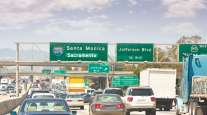Staff Reporter
California Eyes Future Projects to Relieve Freight Congestion

Truck traffic moving through Sacramento may be alleviated by a series of projects the California Department of Transportation has outlined to ease congestion along major freight corridors over the next 10 years.
Caltrans, as the agency is known, created a list of “pinch points” to plan projects that will facilitate traffic on major corridors, including Interstate 5, I-80, I-10 and State Route 60.
Caltrans spokesman Matt Rocco said most of the projects were made possible through the Road Repair and Accountability Act of 2017. The legislation devotes millions for infrastructure improvements throughout the state.
“California has the sixth largest economy in the world. Freight movement plays a huge role, generating about one-third of California’s $2.2 trillion economy,” California Transportation Commission spokeswoman Amy MacPherson said. “Because freight plays such a major role in California’s economy and will continue to do so for decades, it is critical that we continue to fund infrastructure improvements to better facilitate goods movement across the state.”
Several of the projects are directed at improving freight traffic through Sacramento. This includes a $247 million bridge project to replace structures on the I-5 South Connector Undercrossing between U.S. Highway 50 and I-80 in an effort to improve permit load capabilities. Another project will shore up the West End Viaduct along I-5 so that the bridge can accommodate heavier loads. The projects in the Sacramento are scheduled for completion between 2022 and 2026.
Freight movement plays a huge role, generating about one-third of California’s $2.2 trillion economy.
Amy MacPherson, California Transportation Commission spokeswoman
Norman Hom, executive director of the Sacramento Transportation Authority, said that many travelers pass through Sacramento to reach San Francisco, which is located about 90 miles southwest of the state capital. He also said people generally rely on I-5 or I-80 to make this trip.
“There’s a lot of traffic that comes through Sacramento just to get to the Bay Area. I-5 is very popular. It’s one of two major interstates that run through the Sacramento area,” Hom said. “I-5 runs all the way from Mexico to Canada. It’s a major north-south corridor through the Sacramento area.”
Hom said traffic in Sacramento has become more congested in the past few years, partly because the cost of living in San Francisco has vaulted to push people to live farther outside the city.
According to the U.S. Census Bureau, median gross rent in San Francisco between 2012-2016 was $1,632. Hom said these steep housing costs have caused people to flee to other cities, including Sacramento. According to a report from the California Department of Finance, Sacramento had the largest percentage gain in population, or 1.4%, in 2016.

Truck and other traffic on eastbound Highway 50 near Sacramento. (Rich Pedroncelli/Associated Press)
“[Traffic has] worsened significantly. I think what’s happened is housing prices in the San Francisco Bay Area have gotten so out of hand that a lot of people have been moving to Sacramento. A lot of people move to Sacramento and commute to the Bay Area for work,” Hom said. “It’s grown tremendously, and congestion has grown tremendously as well.”
The projects address segments of routes across the entire state. For example, one project calls for strengthening load capacity on several bridges in Chino, which is 35 miles east of Los Angeles. Another aims to remove vertical clearance restrictions along Interstate 5 in Siskiyou County, which is in the northernmost part of the state.
Along the I-80 corridor, Caltrans plans to establish vertical clearance standards where the route connects with Interstates 580 and 880. This intersection, the MacArthur Maze, ranked No. 65 on the American Transportation Research Institute’s 2018 list of top truck bottlenecks.
Chris Shimoda, vice president of government affairs for the California Trucking Association, said this intersection usually carries local trucks and freight movers coming from the nearby Port of Oakland. The Port of Oakland, along with the Ports of Los Angeles and Long Beach, make up California’s major ports.
“California’s interstates and highways carry 40% of the nation’s imports from the ports of Long Beach and Los Angeles to the rest of the country,” Caltrans spokeswoman Erin Gallup von Tersch said. “That’s part of the reason we have so much truck traffic.”
The projects addressing vertical clearance issues, which involve lowering roadways and raising overpasses, are to accommodate larger vehicles and aging infrastructure, Gallup von Tersch said.
“Trucks are getting bigger, just like the ships are getting bigger, and much of our infrastructure was built half a century ago,” Gallup von Tersch. “We need to allow for the larger trucks.”




